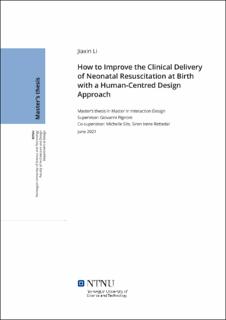| dc.description.abstract | While most babies can breathe independently within the 30s of birth, around 10% need some assistance to establish a successful respiratory transition. And due to the lack of neonatal resuscitation skill and knowledge and the high cognitive workload, studies show a high percentage of non-adherence to the guidelines and high error rates when healthcare professionals (HCPs) resuscitate the newborn.
This research aims to understand how HCPs in Norway provide neonatal resuscitation, what are the barriers and enablers for providing a high-quality resuscitation, and finally using this information to develop an effective solution to support the healthcare professionals through the process and improve their performance.
In order to fulfil the research objectives, a human-centred design approach has been chosen, and both qualitative and quantitative methods have been applied. In the initial stage, survey, field study and individual interview have been used to empathize and have a deeper understanding of the HCPs and healthcare system. Multiple data analysis methods(e.g. persona, journey map) have been used to discover the insights. 2 HCPs have been invited to confirm the insights and to generate design solutions with the author in co-creation workshops. A storyboard which illustrates the final solution together with a medium-fidelity prototype have been tested in a testing workshop with 2 HCPs.
Outcome and contributions from this study include an in-depth understanding of the current practice of neonatal resuscitation in Norway and the related health ecosystem, and provides a better understanding of the barriers and enablers to a high-quality resuscitation, and what expectations and requirements the HCPs have for the solution. Finally, it suggests a tool, when implemented together with Monivent Neo 100 and NeoBeat, which can improve the understanding of the situation for the healthcare professionals during a neonatal resuscitation, and have the potential to improve their performance and adherence to the Norwegian newborn resuscitation guideline. Future work will be to refine the storyboard, to further develop this prototype to include all the planned functions and the interactive components, and to test the usability issues and efficacy of the prototype. | |
